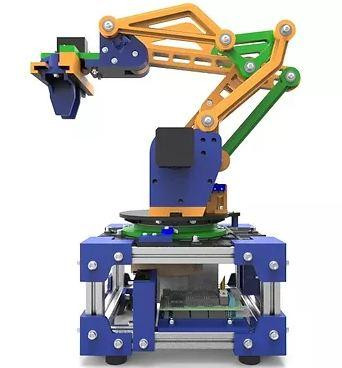The robotic arm design and how it works
The Robotic Arm is a mechanism consisting of tie rods interconnected using suitable joints to obtain the degrees of freedom and spatial movement required for the intended work. Due to its functional resemblance to a human hand, it is also anthropomorphic.
Robotic Arm Design: A typical robotic arm
Consider a manufacturing industry where humans use tools but perform end-to-end tasks to make a product themselves. Now, robots you can build can perform many operations ranging from metal cutting, metal joining, pick & place and component assembly to product labelling, spray painting, etc. The use of electric motors and electronic devices such as microcontrollers to drive mechanical links and joints makes a self-sufficient manipulator an important part of robotic arm design.
The ability of a robotic arm to reproduce results with minimal errors increases its efficiency and speed of operation, so the ideal robot arm design reduces product cycle time and cost. Without human intervention, the risk of injury is also significantly reduced, making it easier to handle hazardous materials.
Types of a robotic arm
- Cartesian Robot / Gantry Robot: Spatial motion and position are defined in the Cartesian coordinate system, and its arm consists of three prismatic joints. The uses of this robot range from gripping and positioning work to handle machine tools, performing arc welding, applying sealants and performing assembly operations.
- Cylindrical Robot: It handles die-cast machines and machine tools and performs assembly and spot welding operations.
- Spherical Robot / Polar Robot: Its axes form the polar coordinate system and are used in gas, arc and spot welding operations, die casting of deburring mechanisms and handling machine tools.
- SCARA Robotinvolves a selective assembly robotic arm, which is especially useful for small robotic assembly operations. As the name suggests, it provides compliance on a plane with two parallel rotating joints and is rigid in the third direction. It manages machine tools, sealant application, assembly operations and picks and place operations.
- Articulated Robot: robotic arm parts uses a range of applications ranging from gas and arc welding, spray painting, deburring machines, die casting and assembly operations.
- Parallel robot: Famous examples are the Stewart platform and the Delta robot. This robot is used in cockpit flight simulators and fibre optic alignment.
Inspired by a human hand, the mechanical aspect of a robotic arm design consists of several links that form a kinematic chain. The links are connected by joints, which provide the rotational and translational capabilities necessary for the mechanism.
Robotic arm control
Robot 6 Axis can have manual control or autonomous capability. In manual mode, a robot is taught to perform its task by a trained operator (programmer) who uses a hand-held controller (a teach pendant) to perform the goal. This is a relatively slow procedure.
A typical small robotic arm has a multilevel control configuration, including a microcontroller, driver, and computer-based user interface. The concepts of inverse kinematics are used to provide flexibility in programming and control methods. This implementation is also possible in manual mode. A typical microcontroller has an associated development/programming board.

Comments
Post a Comment